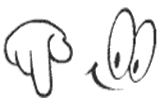Measuring temp of brass/powder depends largely on the situation. As mentioned previously, some keep ammo on their person until it is time to shoot, while others keep it with their rifle and assume ambient temperature. Others don't make assumptions and use infrared right before putting the round into the chamber. Either way, they don't put it into the chamber until right before they shoot. Again, this probably doesn't matter much at shorter ranges, but when start stretching it out beyond 800 - 1000 yards, you ignore it at your own peril. Where I hunt, I often see swings of 50 degrees within five hours, more if in direct sunlight.

